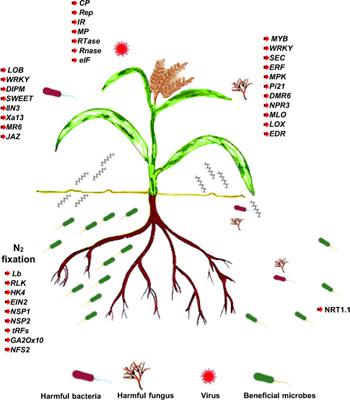当前位置:
X-MOL 学术
›
Curr. Genomics
›
论文详情
Our official English website, www.x-mol.net, welcomes your feedback! (Note: you will need to create a separate account there.)
Understanding the Plant-microbe Interactions in CRISPR/Cas9 era: in-deed a Sprinting start in Marathon
Current Genomics ( IF 2.6 ) Pub Date : 2020-09-16 , DOI: 10.2174/1389202921999200716110853 Seenichamy Rathinam Prabhukarthikeyan 1 , Chidambaranathan Parameswaran 1 , Umapathy Keerthana 1 , Basavaraj Teli 2 , Prasanth Tej Kumar Jagannadham 3 , Balasubramaniasai Cayalvizhi 1 , Periyasamy Panneerselvam 1 , Ansuman Senapati 1 , Krishnan Nagendran 4 , Shweta Kumari 4 , Manoj Kumar Yadav 1 , Sundaram Aravindan 1 , Samantaray Sanghamitra 1
Current Genomics ( IF 2.6 ) Pub Date : 2020-09-16 , DOI: 10.2174/1389202921999200716110853 Seenichamy Rathinam Prabhukarthikeyan 1 , Chidambaranathan Parameswaran 1 , Umapathy Keerthana 1 , Basavaraj Teli 2 , Prasanth Tej Kumar Jagannadham 3 , Balasubramaniasai Cayalvizhi 1 , Periyasamy Panneerselvam 1 , Ansuman Senapati 1 , Krishnan Nagendran 4 , Shweta Kumari 4 , Manoj Kumar Yadav 1 , Sundaram Aravindan 1 , Samantaray Sanghamitra 1
Affiliation

|
Plant-microbe interactions can be either beneficial or harmful depending on the nature of the interaction. Multifaceted benefits of plant-associated microbes in crops are well documented. Specifically, the management of plant diseases using beneficial microbes is considered to be eco-friendly and the best alternative for sustainable agriculture. Diseases caused by various phytopathogens are responsible for a significant reduction in crop yield and cause substantial economic losses globally. In an ecosystem, there is always an equally daunting challenge for the establishment of disease and development of resistance by pathogens and plants, respectively. In particular, comprehending the complete view of the complex biological systems of plant-pathogen interactions, co-evolution and plant growth promotions (PGP) at both genetic and molecular levels requires novel approaches to decipher the function of genes involved in their interaction. The Clustered Regularly Interspaced Short Palindromic Repeats (CRISPR)/Cas9 (CRISPR-associated protein 9) is a fast, emerging, precise, eco-friendly and efficient tool to address the challenges in agriculture and decipher plant-microbe interaction in crops. Nowadays, the CRISPR/CAS9 approach is receiving major attention in the field of functional genomics and crop improvement. Consequently, the present review updates the prevailing knowledge in the deployment of CRISPR/CAS9 techniques to understand plant-microbe interactions, genes edited for the development of fungal, bacterial and viral disease resistance, to elucidate the nodulation processes, plant growth promotion, and future implications in agriculture. Further, CRISPR/CAS9 would be a new tool for the management of plant diseases and increasing productivity for climate resilience farming.
中文翻译:

了解CRISPR/Cas9时代植物-微生物的相互作用:真正的马拉松冲刺起点
植物-微生物相互作用可能是有益的,也可能是有害的,这取决于相互作用的性质。植物相关微生物在作物中的多方面益处已得到充分证明。具体而言,使用有益微生物管理植物病害被认为是生态友好的,是可持续农业的最佳替代方案。由各种植物病原体引起的疾病导致作物产量显着下降,并在全球造成重大经济损失。在生态系统中,病原体和植物分别建立疾病和发展抗性总是同样艰巨的挑战。特别是,理解植物-病原体相互作用的复杂生物系统的完整视图,遗传和分子水平的共同进化和植物生长促进 (PGP) 需要新的方法来破译参与它们相互作用的基因的功能。成簇规则间隔短回文重复序列 (CRISPR)/Cas9(CRISPR 相关蛋白 9)是一种快速、新兴、精确、环保且高效的工具,可应对农业挑战并破译作物中的植物-微生物相互作用。如今,CRISPR/CAS9 方法在功能基因组学和作物改良领域备受关注。因此,本综述更新了 CRISPR/CAS9 技术部署中的普遍知识,以了解植物-微生物相互作用、为发展真菌、细菌和病毒抗病性而编辑的基因,以阐明结瘤过程、促进植物生长、以及未来对农业的影响。此外,CRISPR/CAS9 将成为管理植物病害和提高气候适应力农业生产力的新工具。
更新日期:2020-09-16
中文翻译:

了解CRISPR/Cas9时代植物-微生物的相互作用:真正的马拉松冲刺起点
植物-微生物相互作用可能是有益的,也可能是有害的,这取决于相互作用的性质。植物相关微生物在作物中的多方面益处已得到充分证明。具体而言,使用有益微生物管理植物病害被认为是生态友好的,是可持续农业的最佳替代方案。由各种植物病原体引起的疾病导致作物产量显着下降,并在全球造成重大经济损失。在生态系统中,病原体和植物分别建立疾病和发展抗性总是同样艰巨的挑战。特别是,理解植物-病原体相互作用的复杂生物系统的完整视图,遗传和分子水平的共同进化和植物生长促进 (PGP) 需要新的方法来破译参与它们相互作用的基因的功能。成簇规则间隔短回文重复序列 (CRISPR)/Cas9(CRISPR 相关蛋白 9)是一种快速、新兴、精确、环保且高效的工具,可应对农业挑战并破译作物中的植物-微生物相互作用。如今,CRISPR/CAS9 方法在功能基因组学和作物改良领域备受关注。因此,本综述更新了 CRISPR/CAS9 技术部署中的普遍知识,以了解植物-微生物相互作用、为发展真菌、细菌和病毒抗病性而编辑的基因,以阐明结瘤过程、促进植物生长、以及未来对农业的影响。此外,CRISPR/CAS9 将成为管理植物病害和提高气候适应力农业生产力的新工具。



























 京公网安备 11010802027423号
京公网安备 11010802027423号